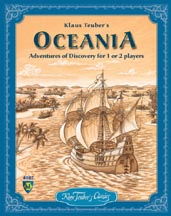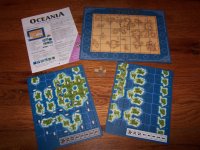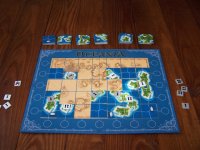
|
Oceania A game by Klaus Teuber Published by Mayfair Games, Inc. and Kosmos Players: 2 Time: 10 minutes Reviewed by Susan Rozmiarek |

|
Oceania is a new game by Klaus Teuber that takes the exploration mechanism from his classic, bigger game Entdecker, and distills it down to a simple game for one or two players. Players will be exploring the realm of "Oceania" by laying tiles on the board. By placing scouts on the islands formed, they hope to score points by having the most scouts on completed islands.
Components:
- A small, mounted, folding game board
- 16 Scout Tiles - two sets of 8, with each tile showing either 1, 2, or 3 scouts
- 35 Sea Tiles
- 25 Reserve Tiles (Sea Tiles with cloud symbols)
- 1 wooden Explorer Ship
- Rules - These are four pages long with color illustrations and printed on heavy paper
Game play:
The reserve tiles are separated into stacks by type and placed near the board.
The sea tiles are placed face down in the box lid and mixed.
Each player takes a set of scout tiles.
The board has a grid of square spaces that represent the unexplored territory. Along the edges of the sides and bottom of the board, there are starting spaces where a player can choose to start a voyage. On a player's turn, he chooses one of these spaces or an already explored tile on the board, to start his voyage and places the wooden ship to mark the location. The starting point must be connected to an unexplored region by a white dotted line. The player then draws a tile from the box lid and tries to place it such that it connects to his starting point. Tiles have white dotted lines across them that show the voyage path and the tile must be placed so that this dotted path connects to the one where the Explorer Ship has been placed. Besides the dotted line, tiles depict either land, water, or a combination on both. If a tile is placed next to another tile or the edge of the board, the type of edge(s), water or land, must match. If a player draws a tile that cannot be placed, he places the tile face up in front of him as a discard and his turn ends.
If a player is able to place a tile that has land on it, he may take one of his unused scout tiles and place in on the land. His turn is now over.
Instead of drawing a tile from the box, a player may choose to use one of his face-up discarded tiles if it legally fits. However, he must pay with one of his unused scout tiles, which is removed form the game. Obviously, it is smarter to use a scout tile with only one pawn instead of the more valuable two and three scout tiles. It is important to try to get rid of these discarded Sea Tiles, as each will score its owner a minus two points at the end of the game.
Another feature of the game that provides some tactical opportunities are surrounded areas. If, on a player's turn, a single unexplored area becomes completely surrounded by Sea Tiles or the edges of the board, the appropriate tile from the reserve deck is automatically placed in this spot. Several spaces can be surrounded if they are completely enclosed by land. The necessary tile or tiles form the reserve deck are immediately placed in this instance as well. In this way it is often possible to complete an island and take the majority with a scout placement.
The game ends when either all the spaces on the board are explored or when all the Sea Tiles are placed. Now completed islands are scored. The player with the most scouts on an island gets points equal to the number of tiles that are a part of the island. After scoring all the islands, each player deducts two points for each discarded tile in front of him and the player with the most points is the winner. The rules suggest playing several rounds since each game takes only about ten minutes.
That's it. It's a very light, simple game that plays in as little as ten to twenty minutes. There are several tactics one can try. A few of these are listed in the rules, but they are fairly obvious after a few plays. One tactic that isn't obvious at first is intentionally trying to get a discarded tile at the beginning of the game. This can then be used to complete an island or ensure that one doesn't complete later in the game.
It is definitely worth mentioning the fact that Oceania comes with rules for solitaire play. Instead of placing scouts for island majorities, the object is to play as many tiles as possible and complete large islands. The player simply draws and places tiles one at a time, discarding tiles he cannot play. Completed islands score the square of the number of tiles that make it up, while each unexplored region counts as minus twenty points. Much like many other solitaire games, this one is dominated by luck but is a pleasant diversion if you like that sort of thing.
Discussion:
I guess my biggest complaint about Oceania is its resemblance to its parent game, Entdecker.
It shares the same theme and graphics, but Entdecker is a much richer game with a lot more depth and complexity.
As Entdecker is a favorite of mine, Oceania left me a little unsatisfied and wanting more.
This is completely unfair and does not do justice to Oceania, though.
Oceania, I think, is intended to be a light, short game that can be enjoyed by children and
casual gamers as well as gamers looking for a quick game.
Oceania fulfills these criteria quite well and I can easily recommend it as such.
It is an excellent introductory tile-laying and area majority game.
| Other Web information: |
This page viewed
E-mail Ed Rozmiarek with questions or problems concerning this page.
Copyright © 2005, Ed & Susan Rozmiarek. No portion of this website may be reproduced or copied without the consent of Ed or Susan Rozmiarek.


